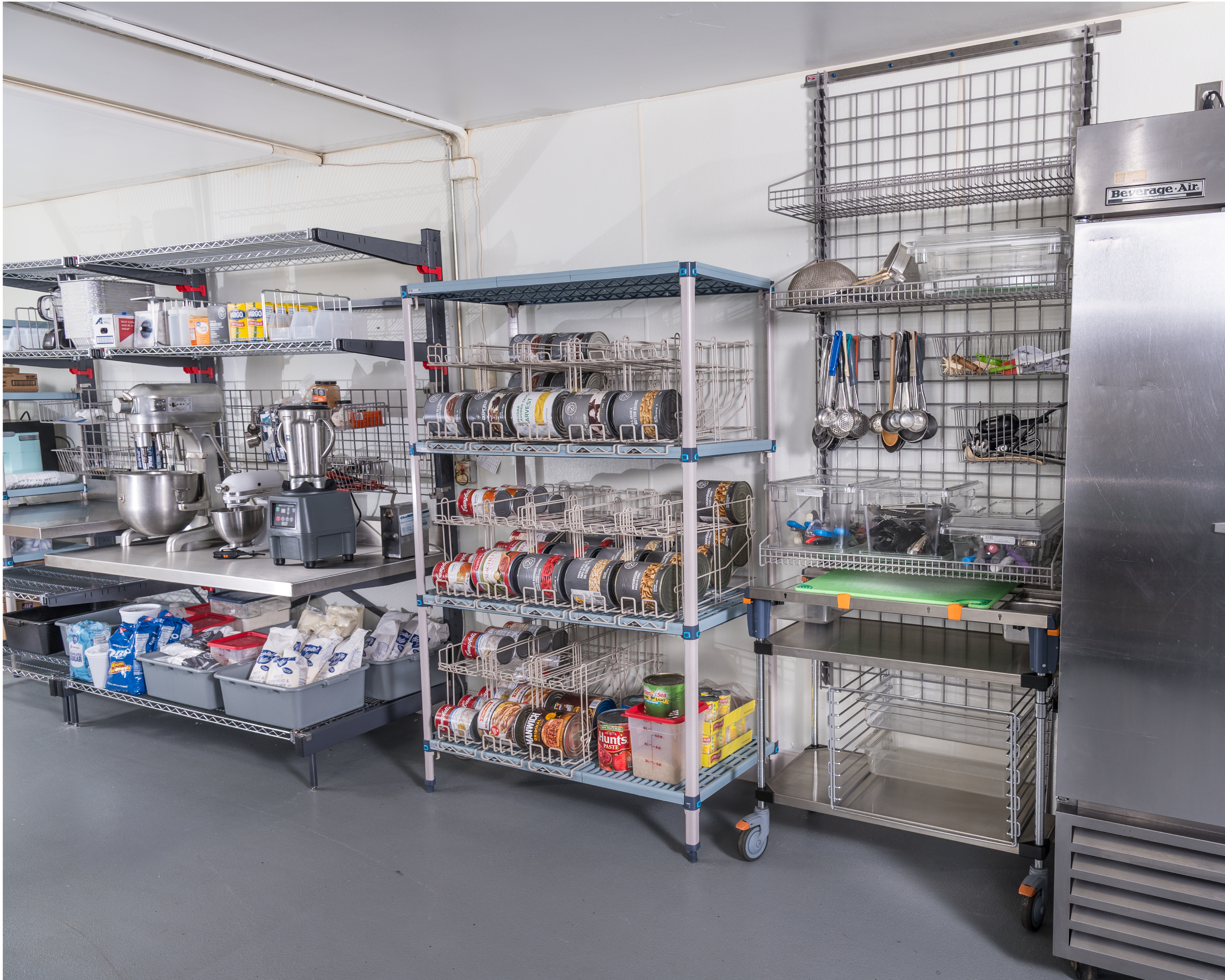When operating a commercial kitchen, upholding food safety standards is vital. Beyond cooking and serving food at proper temperatures, safe long-term food storage is key. This ensures employees can hold and serve food without worrying about spoilage—and public safety.
Proper food storage should be a priority for every food service business and commercial kitchen. Implementing proper storage procedures helps preserve the quality and nutritional value of perishables and prevents spoilage. Even more importantly, proper food storage can help prevent foodborne illnesses caused by harmful bacteria.
At Metro, we know how vital safe storage is in the food industry, which is why we are committed to promoting safe food handling and storage procedures. Wondering where to start? In this guide, we’ll walk you through basic food storage procedures and how you can maintain food safety for your customers and staff.

Understanding the Basics of Food Storage
Food storage is at the heart of every commercial kitchen and is one of the most important aspects of food safety. Proper food storage helps to minimize food waste while reducing cross-contamination and preventing foodborne illnesses.
Primary Types of Storage
Safe food storage requires controlling the environment around the food to prolong its shelf-life. There are three types of storage to consider: dry, refrigerated, and frozen. Each type requires different storage conditions.
Dry Storage
Dry storage is preferable for shelf-stable products and long-term storage solutions for items like canned goods, flour, spices, etc. While dry storage conditions do not need controlled temperature ranges, many items do better when humidity is controlled, especially hygroscopic ingredients like sugar and spices.
Food stored in dry storage should be kept away from chemicals like cleaning products. When it comes to dry storage, you can utilize wire shelving, heavy-duty plastic shelving, or a hybrid shelving unit.
Metro Picks for Dry Storage:
Shop all dry storage solutions
Refrigerated Storage
Time/temperature control for safety (TCS) foods require refrigeration. This type of storage requires maintaining a temperature range of 32°F to 41°F (0°C to 5°C) to prevent spoilage and limit the growth of illness-causing bacteria. Refrigeration storage is best for raw foods and ready-to-eat foods.
Walk-in coolers require specialized shelving that can withstand the cold and humidity of this type of storage environment. Shelving meant for dry storage should not be used in coolers. Any shelving used here should offer protection against the formation of rust and corrosion; you can opt for an epoxy-coated solution like Metroseal or heavy duty plastic shelving.
Metro Picks for Refrigerator Storage:
Shop all refrigerator storage solutions
Freezer Storage
Freezer storage preserves the safety of fresh foods for a long time, including highly perishable foods like meats and leftovers. Temperatures must be kept under 32°F (0°C); below freezing, most food bacteria and other pathogens cease to reproduce.
Metro Picks for Freezer Storage:
Shop all freezer storage solutions
Key Storage Principles
Whether you’re running a restaurant, fast food chain, school cafeteria, or hotel kitchen, food storage guidelines remain the same. These guidelines help food businesses maintain safety and prevent hazards while prepping, serving, and storing food.
Here are some of the best food storage practices to ensure you’re running a safe kitchen:
Monitor Temperatures
Maintaining proper temperatures is fundamental for cold storage, holding, and transport. Temperature fluctuations can lead to various issues, ranging from food spoilage and loss of nutritional value to foodborne illnesses and potential legal issues.
Therefore, it is vital to monitor storage temperatures and keep a log ensuring any fluctuations in temperature are caught quickly.
If you need to hold or transport food for any length of time, it is equally important to maintain temperatures utilizing cabinets or carriers. Metro’s holding cabinets offer versatility and high performance with various levels of moisture and temperature control to hold any dish safely.
For a smaller number of pans, Mightylite insulated food carriers can keep food hot or cold for up to 5 hours—perfect for food delivery or transporting food between locations.

Maintain Cleanliness
In addition to proper temperatures, maintaining a clean storage environment is one of the most crucial elements of maintaining a safe kitchen. Proper kitchen storage is only as successful as the cleanliness of the space; additionally, it is important for employees to maintain proper food-handling hygiene.
Spills and other kitchen accidents are common, which can make keeping the environment clean a challenging task. Fortunately, you can have an easier time keeping back-of-house operations properly sanitized with the right tools.
Did you know that not all storage solutions are created equal? Some simply cannot handle the regular rigorous cleaning demands of a commercial kitchen space. Fortunately, at Metro, we’ve developed storage solutions that are designed to be cleaned.
For easy to clean solutions, consider non-corrosive, NSF certified shelving with removeable shelf mats, such as MetroMax 4.
Rotate Stock (FIFO)
Serving fresh and safe food is important for every commercial kitchen, which is why rotating stock is so necessary. Restaurants, commercial kitchens, and food retailers should enact the first-in, first-out (FIFO) rule to ensure inventory is rotated properly.
The FIFO model reminds us that the oldest items (first-in) should be used before newer inventory (first-out). This ensures that ingredients are used before they expire, thereby limiting food waste in the kitchen.
The best way to ensure a successful FIFO system is to use clear labeling and proper storage guidelines. Everything should have a designated space and be clearly marked, ensuring nothing gets “lost” in the back of the cooler or shelf.
Label Food & Ingredients
Kitchens are busy environments with many moving parts, which is why labeling food with dates and identification is essential.
When prepping, each item should be labeled with the date it was opened/prepped and the date it should be discarded. This will help with stock rotation and following FIFO.
Labels should also be utilized for the most common allergy ingredients, such as tree nuts, peanuts, shellfish, seafood, dairy, eggs, wheat, and soy. Having visible labels in coolers, freezers, and dry storage areas will help avoid cross-contamination and create a more organized space for all staff.
View our full line of shelving accessories.
Limit Cross-Contamination
Within the storage area, it’s important to keep your ingredients organized to prevent cross-contamination with potentially hazardous foods. This applies to potential allergens as well as raw meat.
Always keep cooked and raw products separate and store produce, meats and seafood away from each other. To avoid cross-contamination in the fridge, follow this cooler storage hierarchy:
- Produce
- Cooked Meat
- Dairy
- Fish
- Raw Meat
- Poultry
Focus on Staff Training
The best way to ensure you’re running a safe kitchen is to train your staff in the essential food safety guidelines. Programs like ServSafe offer educational resources, materials, and training to restaurant and foodservice professionals.
When training your staff, ensure they understand the proper procedures for food storage:
- Inspect foods upon receiving and prior to storage
- Maintain and monitor storage temperature
- Handle high-risk foods with care
- Organize foods according to the cooler storage hierarchy
- Always label foods with dates/identification
- Practice FIFO (First-in, First-out)
- Never let food touch the ground
- Store foods in airtight containers
- Avoid refreezing thawed food
- Keep storage areas clean
- Separate and label cleaning materials
- Ensure that hot-held foods are cooked thoroughly
Promoting food safety in your business will help ensure the best experiences for both your customers and staff.
Keep Your Kitchen Safe with Metro’s Foodservice Storage Solutions
Everyone in the foodservice industry has similar goals: serve safe and delicious foods while maintaining profitability. Fortunately, focusing on the right storage solutions can help you meet all your goals.
When you start with the right commercial storage solutions, you set your business up for success. When it comes to shelving, look for easy-to-clean solutions that will keep your cooler, freezer, and dry storage areas organized and sanitary. And when it comes to food holding and transport, look for options that are reliable and functional.
At Metro, our innovative storage solutions are tailored to the unique and demanding needs of commercial kitchens with safety at the forefront. From durable shelving systems to insulated food carriers and everything in-between, our products are engineered to uphold the highest standards of safety and efficiency and to make your job easier.
Explore all our foodservice solutions on our website.
